with复合结构和独立主格(知识梳理)
- 格式:doc
- 大小:44.00 KB
- 文档页数:6
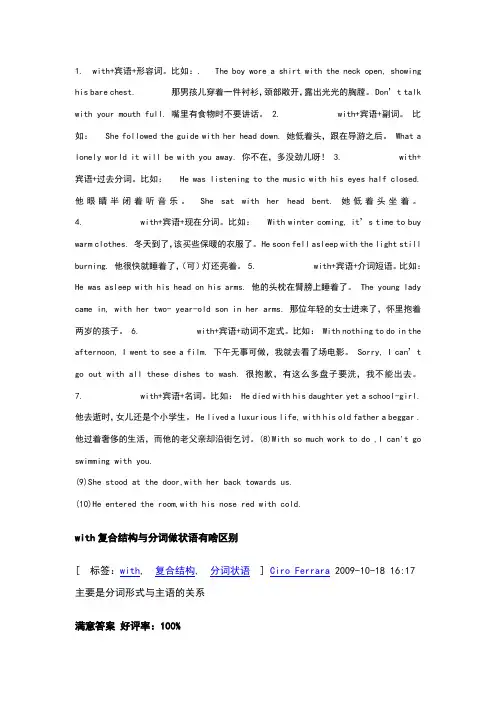
1. with+宾语+形容词。
比如:. The boy wore a shirt with the neck open, showing his bare chest. 那男孩儿穿着一件衬衫,颈部敞开,露出光光的胸膛。
Don’t talk with your mouth full. 嘴里有食物时不要讲话。
2. with+宾语+副词。
比如:She followed the guide with her head down. 她低着头,跟在导游之后。
What a lonely world it will be with you away. 你不在,多没劲儿呀!3. with+宾语+过去分词。
比如:He was listening to the music with his eyes half closed. 他眼睛半闭着听音乐。
She sat with her head bent. 她低着头坐着。
4. with+宾语+现在分词。
比如:With winter coming, it’s time to buy warm clothes. 冬天到了,该买些保暖的衣服了。
He soon fell asleep with the light still burning. 他很快就睡着了,(可)灯还亮着。
5. with+宾语+介词短语。
比如:He was asleep with his head on his arms. 他的头枕在臂膀上睡着了。
The young lady came in, with her two- year-old son in her arms. 那位年轻的女士进来了,怀里抱着两岁的孩子。
6. with+宾语+动词不定式。
比如: With nothing to do in the afternoon, I went to see a film. 下午无事可做,我就去看了场电影。
Sorry, I can’t go out with all these dishes to wash. 很抱歉,有这么多盘子要洗,我不能出去。
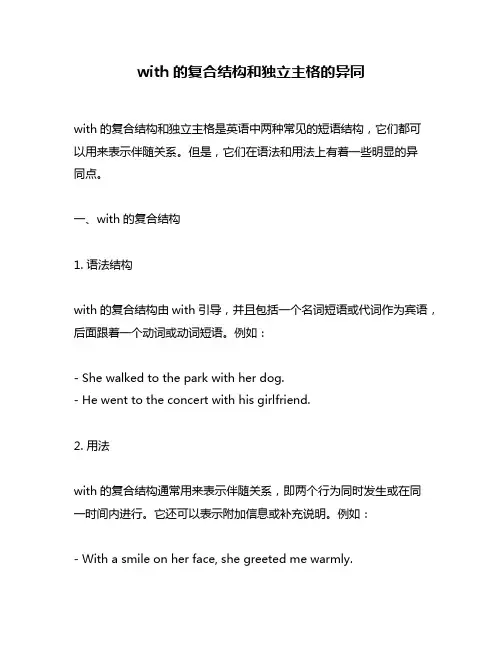
with的复合结构和独立主格的异同with的复合结构和独立主格是英语中两种常见的短语结构,它们都可以用来表示伴随关系。
但是,它们在语法和用法上有着一些明显的异同点。
一、with的复合结构1. 语法结构with的复合结构由with引导,并且包括一个名词短语或代词作为宾语,后面跟着一个动词或动词短语。
例如:- She walked to the park with her dog.- He went to the concert with his girlfriend.2. 用法with的复合结构通常用来表示伴随关系,即两个行为同时发生或在同一时间内进行。
它还可以表示附加信息或补充说明。
例如:- With a smile on her face, she greeted me warmly.- He left the party early with a headache.二、独立主格1. 语法结构独立主格是指一个名词短语或代词加上一个动名词,它们之间没有任何连接词。
例如:- The sun having set, we made our way back home.- Me being sick, I couldn't go to work today.2. 用法独立主格也表示伴随关系,但它更侧重于描述先决条件或原因。
通常情况下,独立主格放在句子的开头,用逗号与主句分开。
例如:- The weather being nice, we decided to have a picnic.- Her parents having died, she was left alone in the world.三、异同点1. 语法结构with的复合结构和独立主格在语法结构上有很大的差别。
前者是一个介词短语加上一个宾语和动词,后者则是一个名词短语或代词加上一个动名词。
2. 用法虽然两种结构都可以表示伴随关系,但是它们在用法上有一些不同。
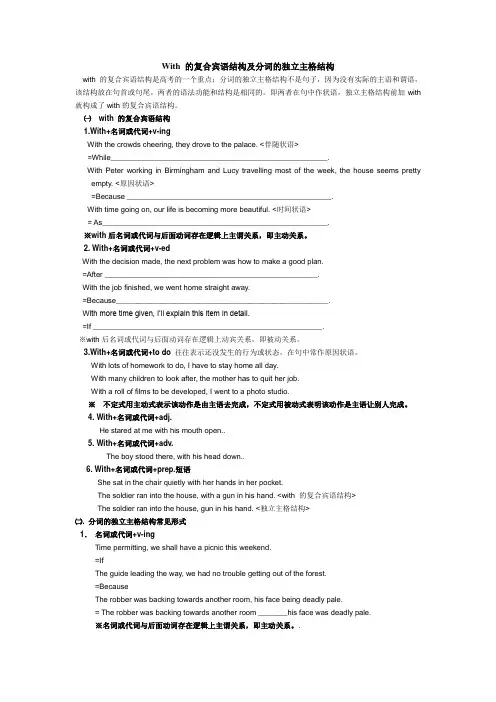
With 的复合宾语结构及分词的独立主格结构with 的复合宾语结构是高考的一个重点;分词的独立主格结构不是句子,因为没有实际的主语和谓语,该结构放在句首或句尾。
两者的语法功能和结构是相同的。
即两者在句中作状语,独立主格结构前加with 就构成了with的复合宾语结构。
㈠with 的复合宾语结构1.With+名词或代词+v-ingWith the crowds cheering, they drove to the palace. <伴随状语>=While____________________________________________________.With Peter working in Birmingham and Lucy travelling most of the week, the house seems pretty empty. <原因状语>=Because _________________________________________________.With time going on, our life is becoming more beautiful. <时间状语>= As______________________________________________________.※with后名词或代词与后面动词存在逻辑上主谓关系,即主动关系。
2. With+名词或代词+v-edWith the decision made, the next problem was how to make a good plan.=After ___________________________________________________.With the job finished, we went home straight away.=Because___________________________________________________.With more time given, I’ll explain this item in detail.=If _______________________________________________________.※with后名词或代词与后面动词存在逻辑上动宾关系,即被动关系。
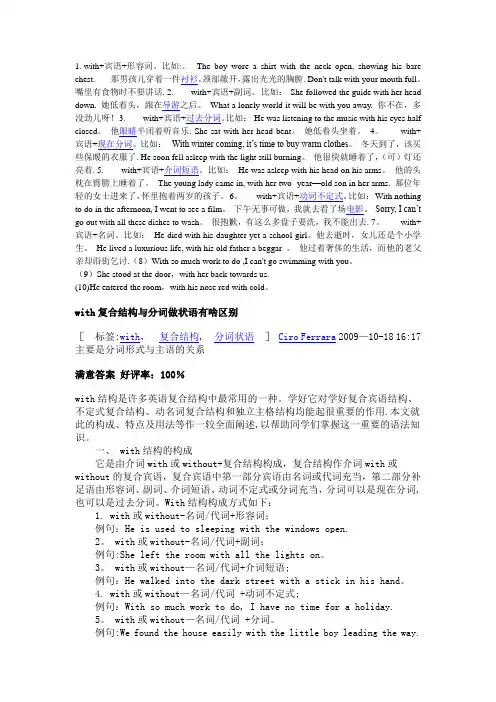
1. with+宾语+形容词。
比如:。
The boy wore a shirt with the neck open, showing his bare chest. 那男孩儿穿着一件衬衫,颈部敞开,露出光光的胸膛. Don't talk with your mouth full。
嘴里有食物时不要讲话.2. with+宾语+副词。
比如: She followed the guide with her head down. 她低着头,跟在导游之后。
What a lonely world it will be with you away. 你不在,多没劲儿呀!3. with+宾语+过去分词。
比如: He was listening to the music with his eyes half closed。
他眼睛半闭着听音乐. She sat with her head bent。
她低着头坐着。
4。
with+宾语+现在分词。
比如:With winter coming, it’s time to buy warm clothes。
冬天到了,该买些保暖的衣服了. He soon fell asleep with the light still burning。
他很快就睡着了,(可)灯还亮着. 5. with+宾语+介词短语。
比如:He was asleep with his head on his arms。
他的头枕在臂膀上睡着了。
The young lady came in, with her two- year—old son in her arms. 那位年轻的女士进来了,怀里抱着两岁的孩子。
6。
with+宾语+动词不定式。
比如:With nothing to do in the afternoon, I went to see a film。
下午无事可做,我就去看了场电影。
Sorry, I can’t go out with all these dishes to wash。
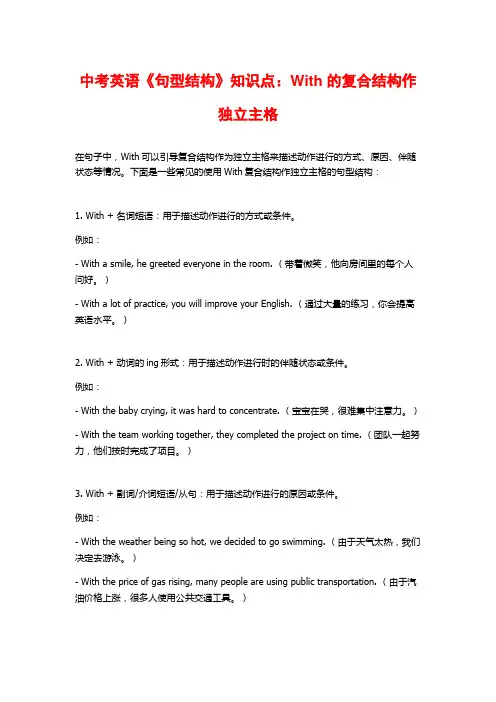
中考英语《句型结构》知识点:With的复合结构作独立主格在句子中,With可以引导复合结构作为独立主格来描述动作进行的方式、原因、伴随状态等情况。
下面是一些常见的使用With复合结构作独立主格的句型结构:1. With + 名词短语:用于描述动作进行的方式或条件。
例如:- With a smile, he greeted everyone in the room. (带着微笑,他向房间里的每个人问好。
)- With a lot of practice, you will improve your English. (通过大量的练习,你会提高英语水平。
)2. With + 动词的ing形式:用于描述动作进行时的伴随状态或条件。
例如:- With the baby crying, it was hard to concentrate. (宝宝在哭,很难集中注意力。
)- With the team working together, they completed the project on time. (团队一起努力,他们按时完成了项目。
)3. With + 副词/介词短语/从句:用于描述动作进行的原因或条件。
例如:- With the weather being so hot, we decided to go swimming. (由于天气太热,我们决定去游泳。
)- With the price of gas rising, many people are using public transportation. (由于汽油价格上涨,很多人使用公共交通工具。
)需要注意的是,With的复合结构作独立主格时,常与主谓语动词形成非限制性定语从句的关系,可以省略关系代词或并列连词(如that, which, and)。
希望以上内容对你有所帮助!。



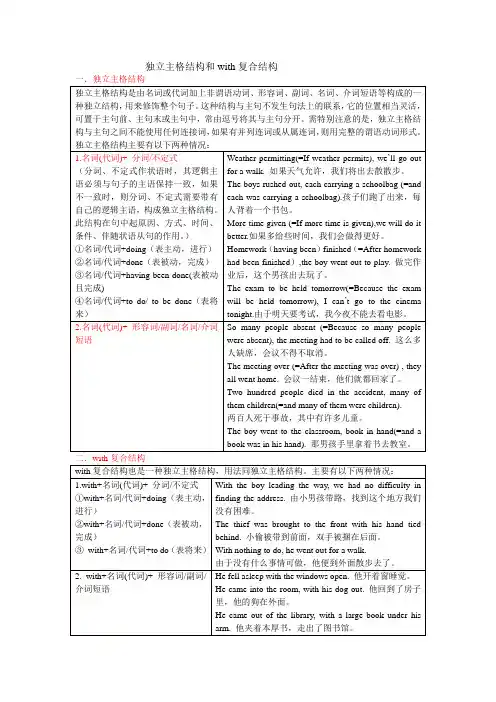
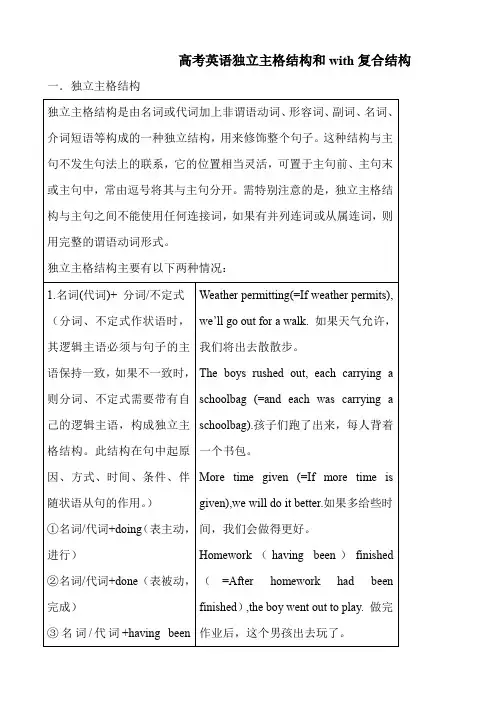
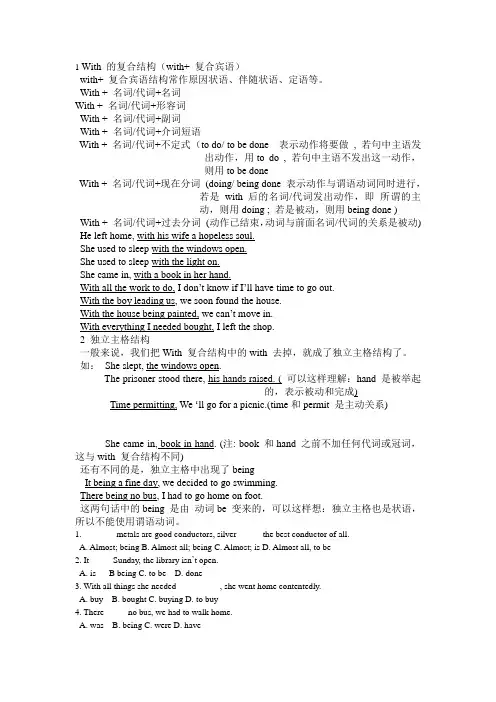
1 With 的复合结构(with+ 复合宾语)with+ 复合宾语结构常作原因状语、伴随状语、定语等。
With + 名词/代词+名词With + 名词/代词+形容词With + 名词/代词+副词With + 名词/代词+介词短语With + 名词/代词+不定式(to do/ to be done 表示动作将要做, 若句中主语发出动作,用to do , 若句中主语不发出这一动作,则用to be doneWith + 名词/代词+现在分词(doing/ being done 表示动作与谓语动词同时进行,若是with 后的名词/代词发出动作,即所谓的主动,则用doing ; 若是被动,则用being done )With + 名词/代词+过去分词(动作已结束,动词与前面名词/代词的关系是被动) He left home, with his wife a hopeless soul.She used to sleep with the windows open.She used to sleep with the light on.She came in, with a book in her hand.With all the work to do, I don’t know if I’ll have time to go out.With the boy leading us, we soon found the house.With the house being painted, we can’t move in.With everything I needed bought, I left the shop.2 独立主格结构一般来说,我们把With 复合结构中的with 去掉,就成了独立主格结构了。
如:She slept, the windows open.The prisoner stood there, his hands raised. ( 可以这样理解:hand 是被举起的,表示被动和完成)Time permitting, We ‘ll go for a picnic.(time和permit 是主动关系)She came in, book in hand. (注: book 和hand 之前不加任何代词或冠词,这与with 复合结构不同)还有不同的是,独立主格中出现了beingIt being a fine day, we decided to go swimming.There being no bus, I had to go home on foot.这两句话中的being 是由动词be 变来的,可以这样想:独立主格也是状语,所以不能使用谓语动词。
独立主格结构和with+复合宾语结构在英语里,独立主格结构和with+复合宾语结构是两种关系非常紧密的句法结构,近年来是各种考试检测的热点和重点。
有的人认为这是两种不同的结构,也有的人把with+复合宾语结构归入独立主格结构中,认为with+复合宾语结构是独立主格结构的一种特殊形式。
这两者之间一般可以转换。
这两种结构既有相似点,又有差异。
在教学过程中,发现学生对这两种结构的认识和理解既不全面,也不透彻。
我根据自己多年的教学经验,觉得用对比法来学习,很容易掌握这两种结构,并能熟练运用,应对各类考试。
在这里,我还是把它们作为两种不同的结构来说明。
一、独立主格结构1.独立主格结构的基本概念独立主格结构是由一个名词或者主格代词加上其它成分(分词、不定式、名词、代词、形容词、副词或介词短语)构成。
名词和代词相当于逻辑主语,其它部分相当于谓语。
这种结构在语法上是一个独立的短语,不是句子,在意思上依附于整个句子。
2.独立主格结构的基本构成及功能独立主格结构主要起状语的作用,相当于一个状语从句,一般用来表示行为方式、伴随情况等,也可以用来表示时间、原因、条件等。
㈠独立主格结构的基本构成名词或代词+分词名词或代词是现在分词所表示的动作的执行者,与现在分词构成逻辑的主谓关系;名词或代词是过去分词所表示的动作的承受者,与过去分词构成逻辑上的动宾关系或系表关系。
The experiment done ,the students went on to take notes in the experiment report. 实验做完了,同学们继续在试验报告上做记录。
He lay on his back, his hands crossed under his head.他脸朝天,头枕着手躺着。
Time permitting, we can finish the work. 如果时间许可,我们能够完成这项工作。
It being Sunday, they had no classes. 由于是星期天,他们不上课。
英语初三年级With的复合结构作独立主格知识点梳理
英语初三年级With的复合结构作独立主格知识点梳理
表伴随时,既可用分词的独立结构,也可用with的复合结构。
with +名词(代词)+现在分词/过去分词/形容词/副词/不定式/介词短语
举例: He stood there, his hand raised.
= He stood there, with his hand raise.
典型例题
The murder was brought in, with his hands ___ behind his back。
A. being tied
B. having tied
C. to be tied
D. tied
答案D. with +名词(代词)+分词+介词短语结构。
当分词表示伴随状况时,其主语常常用with来引导。
由于本句中名词"手"与分词"绑"是被动关系,因此用过去分词,选D.。
1 With 的复合结构(with+ 复合宾语)with+ 复合宾语结构常作原因状语、伴随状语、定语等。
With + 名词/代词+名词With + 名词/代词+形容词With + 名词/代词+副词With + 名词/代词+介词短语With + 名词/代词+不定式(to do/ to be done 表示动作将要做 , 若句中主语发出动作,用to do , 若句中主语不发出这一动作,则用to be done With + 名词/代词+现在分词 (doing/ being done 表示动作与谓语动词同时进行,若是with 后的名词/代词发出动作,即所谓的主动,则用doing ; 若是被动,则用being done )With + 名词/代词+过去分词 (动作已结束,动词与前面名词/代词的关系是被动)He left home, with his wife a hopeless soul.She used to sleep with the windows open.She used to sleep with the light on.She came in, with a book in her hand.With all the work to do, I don’t know if I’ll have time to go out.With the boy leading us, we soon found the house.With the house being painted, we can’t move in.With everything I needed bought, I left the shop.2 独立主格结构一般来说,我们把With 复合结构中的with 去掉,就成了独立主格结构了。
如: She slept, the windows open.The prisoner stood there, his hands raised. ( 可以这样理解:hand 是被举起的,表示被动和完成)Time permitting, We ‘ll go for a picnic.(time和permit 是主动关系)She came in, book in hand. (注: book 和hand 之前不加任何代词或冠词,这与with 复合结构不同)还有不同的是,独立主格中出现了beingIt being a fine day, we decided to go swimming.There being no bus, I had to go home on foot.这两句话中的being 是由动词be 变来的,可以这样想:独立主格也是状语,所以不能使用谓语动词。
with复合结构和独立主格真题再现1. The old couple often take a walk after supper in the park with their pet dog ____ them.A. to followB. followingC. followedD. follows2. The party will be held in the garden, weather .A. permittingB. to permitC. permittedD. permit3. The country has already sent up three unmanned spacecraft, the most recent ______at the end of last March.A. has been launchedB. having been launchedC. being launchedD. to be launched4. John received an invitation to dinner, and with his work_____, he gladly accepted it.A. finishedB. finishingC. having finishedD. was finishing5. —Come on, please give me some ideas about the project.—Sorry. With so much work my mind, I almost break down.A. filledB. fillingC. to fillD. being filled6. ________two exams to worry about, I have to work really hard this weekend.A. BesidesB. WithC. As forD. Because of7. I couldn’t do my homework with all that noise ________.A. going onB. goes onC. went onD. to go on8. They started off late and got to the airport with minutes to _______.A.spare B.catch C.leave D.make答案与解析1. B。
with后接非谓语复合结构,pet dog和follow构成主谓关系,用following。
2. A。
此处主句的主语party 和weather不一致,所以weather保留,作permitting的逻辑主语,构成独立主格结构。
另外,weather与permit之间是主动关系,故用现在分词。
句意:如果天气允许,聚会将在花园举行。
3. B。
此句前后句没连词,只有逗号是不能连接两个句子的,所以后边the most recent ______ at the end of last March就是独立主格的形式了,在句中做伴随状语。
4. A。
and连接前后两个并列句。
在后一个句子中,with结构为独立主格结构,对于finish 的逻辑主语his work来说,是“被完成”,而且不能用谓语结构,选用过去分词表示被动关系。
5. B。
在句子中,with结构为独立主格结构,对于fill的逻辑主语too much work来说,是主谓关系,而且不能用谓语结构,选用现在分词表示主动关系。
6. B。
从句子的结构看这里必须要填一个介词,而不能填连词,“as for” 意思是“至于、关于”;because of意思是“由于、因为”,其后不能跟复合结构,所以不能选择C和D。
在所给的选项中只有with才符合构成“ with + n. / pron. + to do ”结构。
句意是:由于担心这两门考试,本周末我得真的用功了。
7. A。
“with+宾语+现在分词”作宾语补足语,在句中作couldn’t do my homework的原因状语.而all that noise与go on在逻辑上是主谓关系,而且强调动作正在进行,所以用现在分词做宾语补足语。
8. A。
此题考查“with+宾语+不定式”作宾语补足语,在句中作结果状语。
而minutes与to spare 在逻辑上是主谓关系,而且强调动作没有完成,所以用不定式做宾语补足语。
知识讲解with复合结构with复合结构是由“with+复合宾语”组成,常在句中做状语,表示谓语动作发生的伴随情况、时间、原因、方式等。
其构成有下列几种情形:带介词的复合结构He was asleep with his head on his arms.The teacher came into the classroom with a book in his hand.We sat on the dry grass with our backs against the wall.带现在分词的复合结构I won’t be able to go on a holiday with my mother being ill.With winter coming on, it’s time to buy warm clothes. (As winter come s on, it’s time to buy warm clothes.)注意:with和as都译为“随着”,但是with为介词,后接分词结构;as为连词,后接从句。
Ann fell asleep with the light burning.With the price of gold going up, South Africa’s economy was good.常见的“with +复合宾语”结构主要有以下几种形式:1.With+名词+分词/分词短语在这种结构中,名词作with的宾语,分词充当宾语补足语。
判断用现在分词还是过去分词,应根据名词与分词之间的关系。
如果名词与分词之间是主动关系就用现在分词;若名词与分词之间是被动关系,则用过去分词。
With so many people communicating in English every day, it will become more and more important to have a good knowledge of English.有那么多的人天天用英语交流,熟练掌握英语会变得越来越重要。
The thief was forced into the post station with his hands tied back.贼被双手捆绑着带进了派出所。
2.With+名词+不定式在这种结构中,名词作with的宾语,不定式充当宾语补足语,表示尚未发生的动作。
此结构中不定式与名词之间存在动宾关系,但不定式多用主动式。
With a lot of homework to do, I can’t play football with my friends.有这么多的作业要做,我不能跟朋友们踢足球。
With many things to deal with, I have to work day and night.有许多事要处理,我不得不夜以继日地工作。
3.With+名词+介词短语/形容词/副词With的复合结构除了可以在名词后面接非谓语动词外,还可以接介词短语、形容词或副词等。
Don’t stand with your hands in your pockets.站着的时候别把双手插在口袋里。
She saw a small river with green grass and red flowers on both sides.她看到一条小河,两岸长满了红花绿草。
She sleeps with the window open.她爱开着窗户睡觉。
Tian An Men Square looks even more beautiful with all lights on.所有的灯都亮着,天安门广场显得更加漂亮。
独立主格结构非谓语动词作状语时,它的逻辑主语应该是句子的主语。
但有时非谓语动词带有自己的主语,从而在结构上与主语不发生关系,我们称之为独立主格结构。
其实,所谓“独立主格结构”也并非真正独立,它还是一种从属的结构。
在独立主格结构中,非谓语动词和它前面的名词或代词存在着逻辑上的主谓关系或动宾关系。
独立主格结构主要表示谓语动词发生的时间、原因、条件或伴随情况等,在许多情况下相当于一个状语从句或并列句。
1. 用作时间状语The work done (=After the work had been done), we went home. 工作完成后,我们就回家了。
2. 用作条件状语Weather permitting (=If weather permits), they will go on an outing to the beach tomorrow.如果天气允许的话,他们将在明天组织一次海滨小游。
3. 用作原因状语An important lecture to be given tomorrow (=As an important lecture will be given tomorrow), the professor has to stay up late into the night.因为明天要发表一个重要的演讲,教授不得不熬夜到很晚。
4. 用作伴随状语He was lying on the grass, his hands crossed under his head (=and his hands were crossed under his head). 他躺在草地上,两手交叉枕在脑后。
5. 表示补充说明A hunter came in, his face red with cold (=and his face was red with cold).一个猎人走了进来,他的脸冻得通红。
We redoubled our efforts, each man working like two. 我们加倍努力,一个人干两个人的活。
注:独立主格结构表示时间、条件或原因时,相当于一个状语从句,一般放在句首,表示原因时还可放在句末;表伴随状况或补充说明时,相当于一个并列句,通常放于句末。
不定式“独立主格结构”在“逻辑主语+动词不定式”结构中,动词不定式和它前面的名词或代词存在着逻辑上的主谓关系。